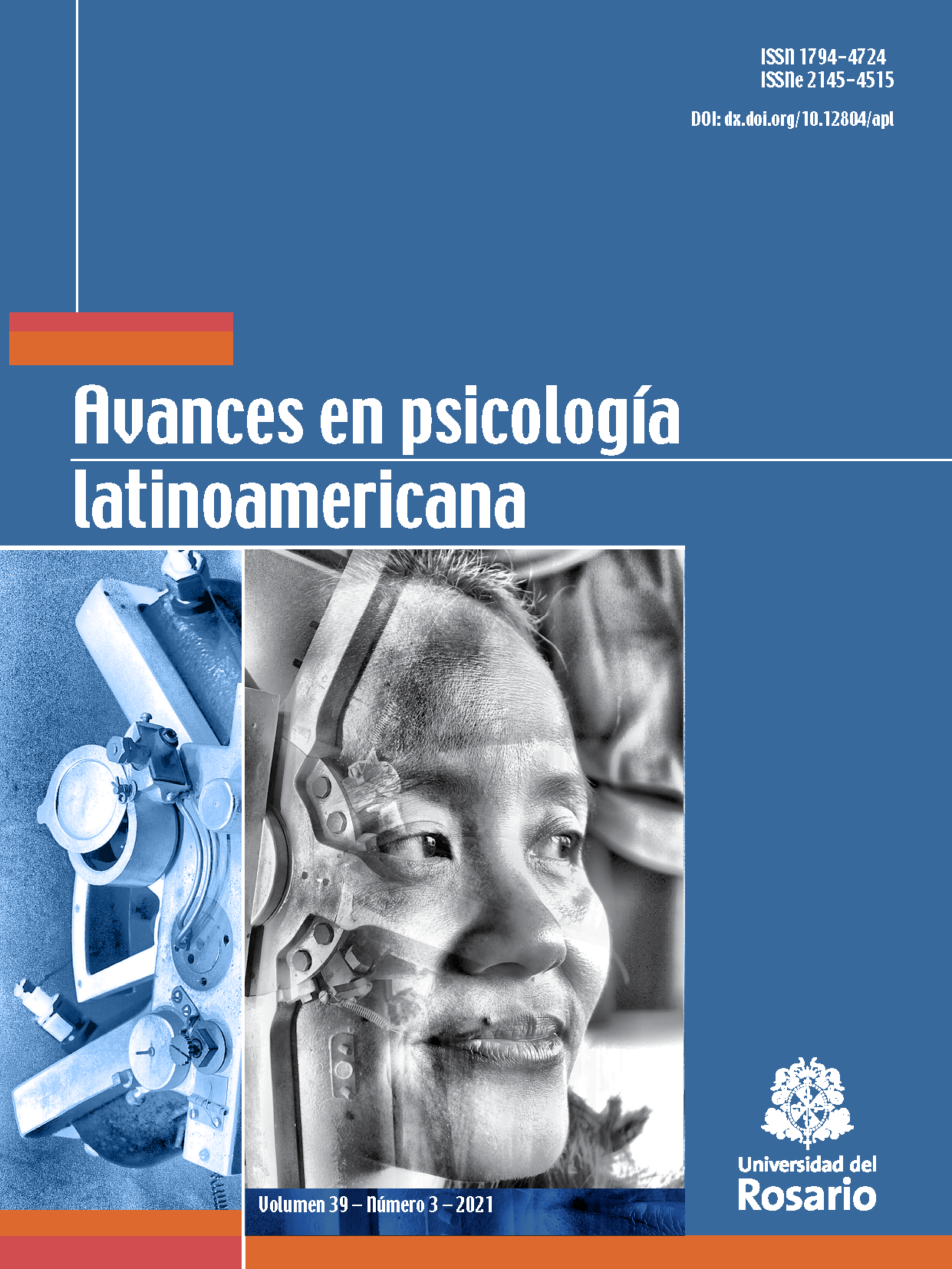Representación de grupos sociales y generalización de disposiciones morales en la infancia
Barra lateral del artículo
Contenido principal del artículo
Desde temprana edad, los niños muestran conocimientos complejos sobre el funcionamiento de los grupos sociales y las disposiciones morales de los individuos que los integran. Los niños de preescolar son capaces de inferir características compartidas por miembros de un mismo grupo social, y de generalizar disposiciones morales entre ellos. La actual investigación buscó comprender mejor las condiciones de generalización de disposiciones morales en diferentes tipos de agrupaciones de individuos. A lo largo de dos estudios (n = 180), y mediante un paradigma de generalización inductiva, se indagó la manera como niños de cinco y siete años de edad generalizan disposiciones morales, variando las características de los grupos sociales presentados. Los resultados mostraron que los niños no utilizan únicamente la presencia de etiquetas verbales comunes entre los miembros para guiar la generalización; por el contrario, este proceso parece más restringido, en función de las características observadas del grupo social. Estos hallazgos revelan que la identificación de disposiciones morales y su generalización en los individuos de un grupo social es un proceso de emergencia relativamente temprana en el desarrollo y de naturaleza compleja.
Descargas
Baillargeon, R., Setoh, P., Sloane, S., Jin, K., & Bian, L. (2014). Infant social cognition: Psychological and sociomoral reasoning. En M. S. Gazzaniga & G. R. Mangun (Eds.), The cognitive neurosciences (5th ed) (pp. 7-14). MIT Press.
Bar-Haim, Y., Ziv, T., Lamy, D., & Hodes, R. (2006). Nature and nurture in own-race face processing. Psychological Science, 17(2), 159-163. https://journals.sagepub.com/doi/abs/10.1111/j.1467-9280.2006.01679.x
Baron, A. S., Dunham, Y., Banaji, M., & Carey, S. (2014). Constraints on the acquisition of social category concepts. Journal of Cognition and Development, 15(2), 238-268. https://doi.org/10.1080/15248372.2012.742902
Bastian, B., & Haslam, N. (2006). Psychological essentialism and stereotype endorsement. Journal of Experimental Social Psychology, 42(2), 228-235. https://doi.org/10.1016/j.jesp.2005.03.003
Birnbaum, D., Deeb, I., Segall, G., Ben-Eliyahu, A., & Diesendruck, G. (2010). The development of social essentialism: The case of Israeli children’s inferences about Jews and Arabs. Child Development, 81(3), 757-777. https://doi.org/10.1111/j.1467-8624.2010.01432.x
Buyukozer-Dawkins, M., Sloane, S., & Baillargeon, R. (2019). Do infants in the first year of life expect equal resource allocations? Frontiers in Psychology, 10, Artículo 116. https://doi.org/10.3389/fpsyg.2019.00116
DeCasper, A. J., & Fifer, W. P. (1980). Of human bonding: Newborns prefer their mothers’ voices. Science, 208(4448), 1174-1176. https://www.science.org/doi/abs/10.1126/science.7375928
Dewar, K., & Xu, F. (2010). Induction, overhypothesis, and the origin of abstract knowledge: Evidence from 9-month-old infants. Psychological Science, 21(12), 1871-1877. https://journals.sagepub.com/doi/abs/10.1177/0956797610388810
Diesendruck, G. (2001). Essentialism in Brazilian children’s extensions of animal names. Developmental Psychology, 37(1), 49-60. https://doi.org/10.1037/0012-1649.37.1.49
Diesendruck, G., & Eldror, E. (2011). What children infer from social categories. Cognitive Development, 26(2), 118-126. https://doi.org/10.1016/j.cogdev.2010.11.001
Diesendruck, G., Goldfein-Elbaz, R., Rhodes, M., Gelman, S. A., & Neumark, N. (2013). Cross-cultural differences in children’s beliefs about the objectivity of social categories. Child Development, 84(6), 1906-1917. https://doi.org/10.1111/cdev.12108
Diesendruck, G., & HaLevi, H. (2006). The role of language, appearance, and culture in children’s social category based induction. Child Development, 77(3), 539-553. https://doi.org/10.1111/j.1467-8624.2006.00889.x
Diesendruck, G., & Weiss, E. (2015). Children’s differential weighting of cues to social categories. Cognitive Development, 33, 56-72. https://doi.org/10.1016/j.cogdev.2014.06.001
Dunbar, R. (2016). Human evolution: Our brains and behavior. Oxford University Press. Dunham, Y., Baron, A. S., & Carey, S. (2011). Consequences of ‘minimal groups’ affiliations in children. Child Development, 82(3), 793-811.
https://doi.org/10.1111/j.1467-8624.2011.01577.x
Dunham, Y., & Emory, J. (2014). Of affect and ambiguity: The emergence of preference for arbitrary ingroups. Journal of Social Issues, 70(1), 81-98. https://doi.org/10.1111/josi.12048
Foster-Hanson, E., & Rhodes, M. (2020). How origin stories shape children’s social reasoning.
Cognitive Development, 56, 1-15. https://doi.org/10.1016/j.cogdev.2020.100962
Gelman, S. A. (2003). The essential child: Origins of essentialism in everyday thought. Oxford
University Press.
Gelman, S. A., & Markman, E. M. (1986). Categories and induction in young children. Cognition, 23(3), 183-209. https://doi.org/10.1016/0010-0277(86)90034-X
Gil-White, F. J. (2001). Are ethnic group’s biological “species” to the human brain? Essentialism in our cognition of some social categories. Current Anthropology, 42(4), 515-554.
https://doi.org/10.1086/321802
Hamlin, J. K., Wynn, K., & Bloom, P. (2007). Social evaluation by preverbal infants. Nature, 450, 557-559. https://doi.org/10.1038/nature06288
Hamlin, J. K. (2013). Moral judgment and action in preverbal infants and toddlers: Evidence for an innate moral core. Current Directions in Psychological Science, 22(3), 186-193. https://journals.sagepub.com/doi/abs/10.1177/0963721412470687
Haslam, N., Rothschild, L., & Ernst, D. (2000). Essentialist beliefs about social categories. British Journal of Social Psychology, 39(1), 113-127. https://doi.org/10.1348/014466600164363
Hirschfeld, L. A. (1996). Race in the making: Cognition, culture, and the child’s construction of human kinds. MIT Press.
Kalish, C. W. (2012). Generalizing norms and preferences within social categories and individuals. Developmental Psychology, 48(4), 1133-1143. https://doi.org/10.1037/a0026344
Kinzler, K. D., & Dautel, J. B. (2012). Children’s essentialist reasoning about language and race.
Developmental Science, 15(1), 131-138. https://doi.org/10.1111/j.1467-7687.2011.01101.x
Kinzler, K. D., Dupoux, E., & Spelke, E. S. (2007). The native language of social cognition. Proceedings of the National Academy of Sciences, 104(30), 12577-12580. https://doi.org/10.1073/pnas.0705345104
Kuhlmeier, V., Wynn, K., & Bloom, P. (2003). Attribution of dispositional states by 12-month-olds. Journal of Cognitive Neuroscience, 14(5), 402-408. https://journals.sagepub.com/doi/abs/10.1111/1467-9280.01454
Liberman, Z., Howard, L. H., Vasquez, N. M., & Woodward, A. L. (2018). Children’s expectations about conventional and moral behaviors of ingroup and outgroup members. Journal of Experimental Child Psychology, 165, 7-18. https://doi.org/10.1016/j.jecp.2017.03.003
Liberman, Z., Woodward, A. L., Sullivan, K. R., & Kinzler, K. D. (2016). Early emerging system for reasoning about the social nature of food. Proceedings of the National Academy of Sciences of the United States of America, 113(34), 9480-9485. https://doi.org/10.1073/pnas.1605456113
Plötner, M., Over, H., Carpenter, M., & Tomasello, M. (2016). What is a group? Young children’s perceptions of different types of groups and group entitativity. plos one, 11(3), Artículo e0152001. https://doi.org/10.1371/journal.pone.0152001
Powell, L. J., & Spelke, E. S. (2013). Preverbal infants expect members of social groups to act alike. Proceedings of the National Academy of Sciences, 110(41), E3965-E3972. https://doi.org/10.1073/pnas.1304326110
Prentice, D. A., & Miller, D. T. (2007). Psychological essentialism of human categories. Current Directions in Psychological Science, 16(4), 202-206. https://journals.sagepub.com/doi/abs/10.1111/j.1467-8721.2007.00504.x
Rhodes, M., & Baron, A. (2019). The development of social categorization. Annual Review of Developmental Psychology, 1, 359-386.
https://doi.org/10.1146/annurev-devpsych-121318-084824
Rhodes, M. (2012). Naïve theories of social groups. Child Development, 83(6), 1900-1916. https://doi.org/10.1111/j.1467-8624.2012.01835.x
Rhodes, M. (2013). How two intuitive theories shape the development of social categorization. Child Development Perspectives, 7(1), 12-16. https://doi.org/10.1111/cdep.12007
Rhodes, M., & Chalik, L. (2013). Social categories as markers of intrinsic interpersonal obligations. Psychological Science, 24(6), 999-1006. https://journals.sagepub.com/doi/abs/10.1177/0956797612466267
Rhodes, M., & Gelman, S. A. (2009a). Five-yearolds’ beliefs about the discreteness of category boundaries for animals and artifacts. Psychonomic Bulletin & Review, 16(5), 920-924.
https://doi.org/10.3758/PBR.16.5.920
Rhodes, M., & Gelman, S. A. (2009b). A developmental examination of the conceptual structure of animal, artifact, and human social categories across two cultural contexts. Cognitive Psychology, 59(3), 294-274. https://doi.org/10.1016/j.cogpsych.2009.05.001
Rhodes, M., Gelman, S. A., & Karuza, J. C. (2014). Preschool ontology: The role of beliefs about category boundaries in early categorization. Journal of Cognition and Development, 15(1),
-93. https://doi.org/10.1080/15248372.2012.713875
Schmidt, M. F. H., & Tomasello, M. (2012). Young children enforce social norms. Current Directions in Psychological Science, 21(4), 232-236. https://journals.sagepub.com/doi/abs/10.1177/0963721412448659
Schmidt, M. F. H., Rakoczy, H., & Tomasello, M. (2012). Young children enforce social norms selectively depending on the violator’s group affiliation. Cognition, 124(3), 325-333. https://doi.org/10.1016/j.cognition.2012.06.004
Sloane, S., Baillargeon, R., & Premack, D. (2012). Do infants have a sense of fairness? Psychological Science, 23(2), 196-204. https://journals.sagepub.com/doi/abs/10.1177/0956797611422072
Spelke, E. S., & Kinzler, K. D. (2007). Core knowledge. Developmental Science, 10(1), 89-96. https://doi.org/10.1111/j.1467-7687.2007.00569.x
Taborda-Osorio, H., Cheries, E., & Lyons, A. B. (2019). Examining infants’ individuation by sociomoral disposition. Frontiers in Psychology, 10, Artículo 1271. https://doi.org/10.3389/fpsyg.2019.01271
Taylor, M. G., Rhodes, M., & Gelman, S. A. (2009). Boys will be boys; cows will be cows: Children’s essentialist reasoning about gender categories and animal species. Child Development, 80(2), 461-481. https://doi.org/10.1111/j.1467-8624.2009.01272.x
Tomasello, M. (2016). A natural history of human morality. Harvard University Press.
Tomasello, M. (2019). Becoming human: A theory of ontogeny. Harvard University Press.
Vaish, A., Carpenter, M., & Tomasello, M. (2016). The early emergence of guilt-motivated prosocial behavior. Child Development, 87(6), 1772-1782. https://doi.org/10.1111/cdev.12628
Wynn, K. (2008). Some innate foundations of social and moral cognition. En P. Carruthers, S.
Laurence & S. Stich (Eds.), The innate mind: Foundations and the future (pp. 330-347). Oxford University Press.
Detalles del artículo

Esta obra está bajo una licencia internacional Creative Commons Atribución-NoComercial-SinDerivadas 4.0.
Los autores conservan los derechos de autor y garantizan a la revista el derecho de ser la primera publicación del trabajo al igual que licenciado bajo una Creative Commons Attribution License que permite a otros compartir el trabajo con un reconocimiento de la autoría del trabajo y la publicación inicial en esta revista.








